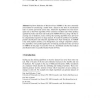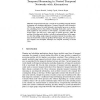5699 search results - page 33 / 1140 » Alternating model trees |
103
Voted
IFIP12
2008
15 years 11 days ago
2008
Top Down Induction of Decision Trees (TDIDT) is the most commonly used method of constructing a model from a dataset in the form of classification rules to classify previously unse...
PODS
1989
ACM
15 years 3 months ago
1989
ACM
The alternating xpoint of a logic program with negation is de ned constructively. The underlying idea is monotonically to build up a set of negative conclusions until the least xp...
ICLP
1992
Springer
15 years 3 months ago
1992
Springer
: Whiledecision tree compilationis a promisingway tocarry out guard tests e ciently, the methods given in the literature do not take into account either the execution characteristi...
SAC
2008
ACM
14 years 10 months ago
2008
ACM
We consider analysis of complex stochastic models based upon partial information. MCMC and reversible jump MCMC are often the methods of choice for such problems, but in some situ...
79
Voted
CSCLP
2007
Springer
15 years 5 months ago
2007
Springer
Temporal networks play a crucial role in modeling temporal relations in planning and scheduling applications. Temporal Networks with Alternatives (TNAs) were proposed to model alte...




